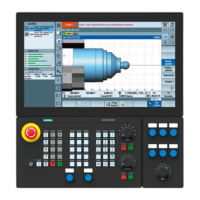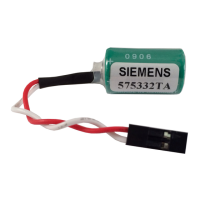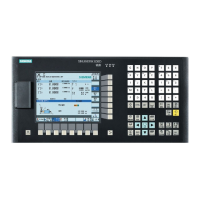11.03 3 Safety-Related Functions
3.2 External STOPs
© Siemens AG 2003 All Rights Reserved
SINUMERIK 840D/SIMODRIVE 611 digital SINUMERIK Safety Integrated (FBSI) - Edition 11.03
3-79
The internal stop responses STOPS A (pulse cancellation), STOP C (braking
with n
set
= 0) and STOP D (braking along a path) triggered by safe monitoring
functions brake the drive accordingly and also trigger an alarm that must be
acknowledged with power on or reset.
When an external STOP is triggered, only STOP A or braking of the drive
(STOP C or STOP D) is triggered and monitored through two channels. Other
responses are only triggered if monitoring thresholds, that are still active, are
violated.
Note
• Alarms are not displayed for an external STOP, i.e., the user must
configure his own message.
• An external STOP E in contrast to the other external stops, results in
Alarm 27020, which can only be acknowledged with a reset. The
program cannot be directly continued, since the axis was retracted from
the desired contour by the configured ESR. The reset required must also
be considered during the test stop sequence.
When a stop type has been requested it can be canceled by one of the
following events via SGE:
• De-selection of the stop request
• Selection of a stop request via SGE with a higher priority
• Receipt of a higher priority stop request (STOP A, B, C, or D) from the
internal monitoring
When a stop response is triggered, it has the following effect on all of the other
axes in the same channel:
STOP E: extended stop and retraction is initiated
STOP D: braking along a path
STOP C: IPO rapid stop (braking at the current limit)
STOP A: IPO rapid stop (braking at the current limit)
The effect on other axes in the channel can be influenced via the
MD $MA_SAFE_IPO_STOP_GROUP. In this way the pulses of a spindle, for
example, can be safely canceled (via external STOP A) so that the spindle can
be manually turned and the axes moved while still being safely monitored.
STOP $MA_SAFE_IPO_STOP_GROUP = 0 $MA_SAFE_IPO_STOP_GROUP = 1
C before SW 6.3.21
All axes of the channel decelerate at the
current limit.
Axes that interpolate with the affected axis
brake at the current limit. All other axes do not
brake.
C
from SW 6.3.21
Axes that interpolate with the affected axis
brake at the current limit. All other axes brake
along the parameterized braking ramp.
Axes that interpolate with the affected axis
brake at the current limit. All other axes do not
brake.
D
Axes/spindles brake along the path or along
the parameterized braking ramp.
Axes that interpolate with the affected axis
brake along the parameterized braking ramp.
All other axes do not brake.
Differences between
stopping via internal
STOP A, C, D and
external STOP A, C, D
via SGEs
Acknowledging a stop
request
Effects of the stop
responses on other
axes/spindles

